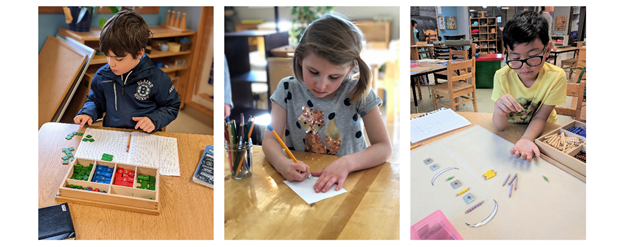5 Traits Nurtured in the Montessori Environment
When we choose a course of education for our children, there are many things to consider. At a certain point, we begin to wonder how various models align with our own personal values. What is important? What should the goals of education be? What do we want our children to gain from the experience?
These factors depend on why and how the methods were developed. What were the initial goals when a particular approach was conceived? What do current practitioners value? These are important questions to consider.
Montessori educators care deeply about the academics we teach, because we are curious people who are fascinated with the world around us. But we are enthusiastic about other aspects of children’s development, too. We want the children in our care to go out into the world feeling good about themselves, caring about others, and excited about what they do. That is what drives our work. That is what makes us feel so strongly about what we do.
Here are five traits Montessori education nurtures in children:
1. Kindness
Interpersonal skills are some of the most important skills we can teach our students. They can learn all the math and language arts skills out there, but if they cannot interact with other people their lives will not feel fulfilling. More than that, we think humans can accomplish so much more together than individually, it is essential to learn to have a good relationship with one another.
The very structure of the Montessori day allows for time dedicated to planned and spontaneous lessons about kindness. We read stories that teach children how to manage challenging situations. We use role-playing games to make the work fun, called Grace and Courtesy. When a conflict happens in the classroom or the playground, we facilitate the children’s skills in the moment. How do we handle our own emotions? How do we communicate with someone we disagree with? What does it look like to disagree but still respect one another?
Sometimes the work consists of giving children the script to work through solving issues. Sometimes we enlist the help of the whole group, discussing problems and asking for solutions without targeting individuals.
2. Powerful Work Ethic
The Montessori approach focuses on intrinsic motivation. Extrinsic motivation can be effective in small doses and with short-term goals, like when you do not want to do the dishes and reward yourself with an iced coffee afterward. Those types of rewards, however, are not particularly effective at cultivating a deep motivation to learn or help others.
It may seem shocking that Montessori schools do not give grades, have tests, or hold award ceremonies. The real world does not function like that, so why should we teach children one type of motivation and then expect them to switch to something else as adults? Are employees evaluated at work? Absolutely. The thing is, they are not receiving grades; they receive narrative feedback that highlights their areas of strengths and on what they might improve. We do the same with our students.
You may have heard the argument that instead of saying “good job” to our children, we should replace that with observations such as “I notice you worked hard on that. How does it feel to complete it?” Putting the emphasis on a person’s efforts, rather than our judgment of their accomplishments, helps nurture a developing sense of internal motivation.
Rather than focusing on accolades, our students grow with a desire to solve problems, gain insights, and pursue their passions.
3. Creativity
Put simply, Montessori encourages creativity in two main ways: we incorporate the arts whenever possible, and we give children a chance to find their own solutions to problems.
Montessori Guides integrate art education in countless ways. Here is just a small sampling of what may happen in a classroom during the year:
Painting, using chalk, oil pastels or other media for free form expression
Drawing, labeling, and painting maps
Listening to music or learning the traditional dance of a culture being studied
Drawing and labelling the external parts of an animal
Reading biographies about influential artists
Teaching sewing or weaving as practical life
The other aspect of creativity involves the way we encourage our students to think. We do not provide all the answers or solutions. We give lessons or “presentations” and provide students with factual information. But when they run up against a problem, we do not race to give them the solution. Whether it be social, academic, or something else altogether, we ask guiding questions that lead the child to generate their own workable solutions. This is one of the keys to developing innovative mindsets.
4. Joyful Learning
When it comes to creating joyful learners, intrinsic motivation and creativity are a good start. Combine that with copious amounts of freedom and gorgeous autodidactic (self-teaching) materials, and you have an environment that children will thrive in.
Learning should be enjoyable, challenging, but also satisfying. We are invested in helping our students to become adults who love to learn and pursue learning independently for the rest of their lives. Even the most basic of skills can be delivered in ways that are engaging. Take the Montessori addition snake game for example: it’s a game, and it involves making snakes out of colorful groupings of beads, then eventually transforming the snake until it’s entirely gold. It is fun but has an academic foundation: learning how to exchange smaller numbers to make ten in preparation for multiplication work and memorization of addition facts.
5. Service-Mindedness
It is important to give our children a sense of the world as a whole and to see the ways in which everything is connected and interdependent.
This belief is embedded into our curriculum, and most obvious in history lessons. In lower elementary, children learn first about the beginnings of our universe, followed by the formation of Earth, then the evolution of life on our planet. Later, they explore early humans and early civilizations. It is not until adolescence that they begin to learn about more recent periods in history.
This is intentional. We believe learning about those who have come before us instills a sense of gratitude and dedication to others.
We also make a point of launching student-driven service projects. These tend to start small and may focus on the school community. As students get older, their capabilities and visions expand outward into the greater local community. These projects will be different every year because they are student led.
These five traits are just a glimpse into some of Montessori’s most revered values. There are plenty more, including cultivating independence which is essential for development.




